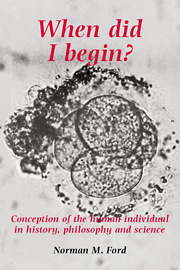Book contents
- Frontmatter
- Contents
- Foreword
- Preface
- 1 Introduction
- 2 Historical influence of Aristotle on the theory of human reproduction
- 3 Criteria for being a human individual
- 4 Fertilization and the beginning of a human individual
- 5 Implantation and the beginning of the human individual
- 6 The human individual begins after implantation
- Appendixes
- Notes
- Glossary
- Index
1 - Introduction
Published online by Cambridge University Press: 03 February 2010
- Frontmatter
- Contents
- Foreword
- Preface
- 1 Introduction
- 2 Historical influence of Aristotle on the theory of human reproduction
- 3 Criteria for being a human individual
- 4 Fertilization and the beginning of a human individual
- 5 Implantation and the beginning of the human individual
- 6 The human individual begins after implantation
- Appendixes
- Notes
- Glossary
- Index
Summary
Interest in the beginning of the human individual: the purpose of this book
From time immemorial, people have been fascinated about the origin of the human race. Ancient myths abound. The Genesis story of Adam and Eve is known well enough. That is how the Bible represents the beginning of the human race through the direct creative intervention of God. If all we knew was that God created man and woman with the same human nature, we ourselves might not do much better than the author of Genesis when it came to depicting how this might have happened.
The theory of evolution presented a challenge to science as well as to the imagination when it was a question of explaining exactly how the first humans appeared on earth. A greater challenge was presented to philosophers and theologians when, without prejudice to their belief in the creation of the soul, they had to explain how, in pre-historic times, animal life could have been transformed into human life, a human being, a Homo. The term hominization was coined to refer to this process. The enormous leap beyond animal consciousness to typical human rational self-consciousness could only have occurred in virtue of the presence and functioning of a rational life-principle or soul. It is the soul that constitutes matter into a living human individual. Being animated by such a spiritual soul would have sufficed to change a form of animal life into a human being. Signs of this newly acquired, reflective self-awareness would have provided sufficient empirical evidence to convince any reasonable observer that the momentous change of hominization had occurred.
- Type
- Chapter
- Information
- When Did I Begin?Conception of the Human Individual in History, Philosophy and Science, pp. 1 - 18Publisher: Cambridge University PressPrint publication year: 1988



